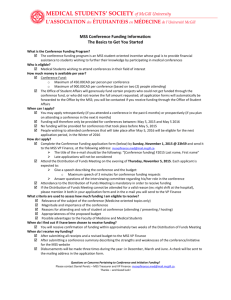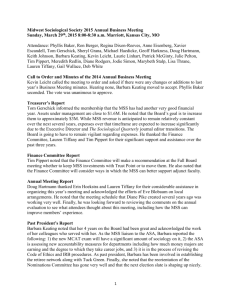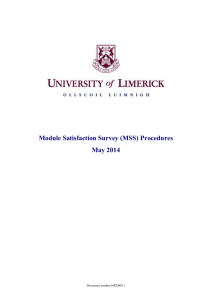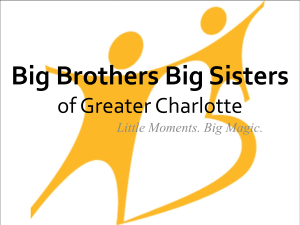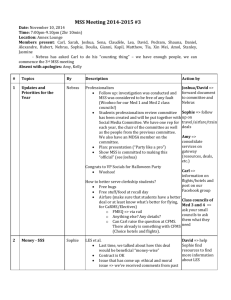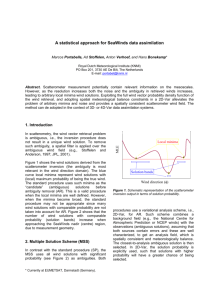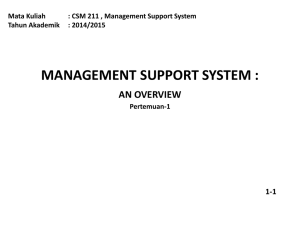Management Support Systems
advertisement
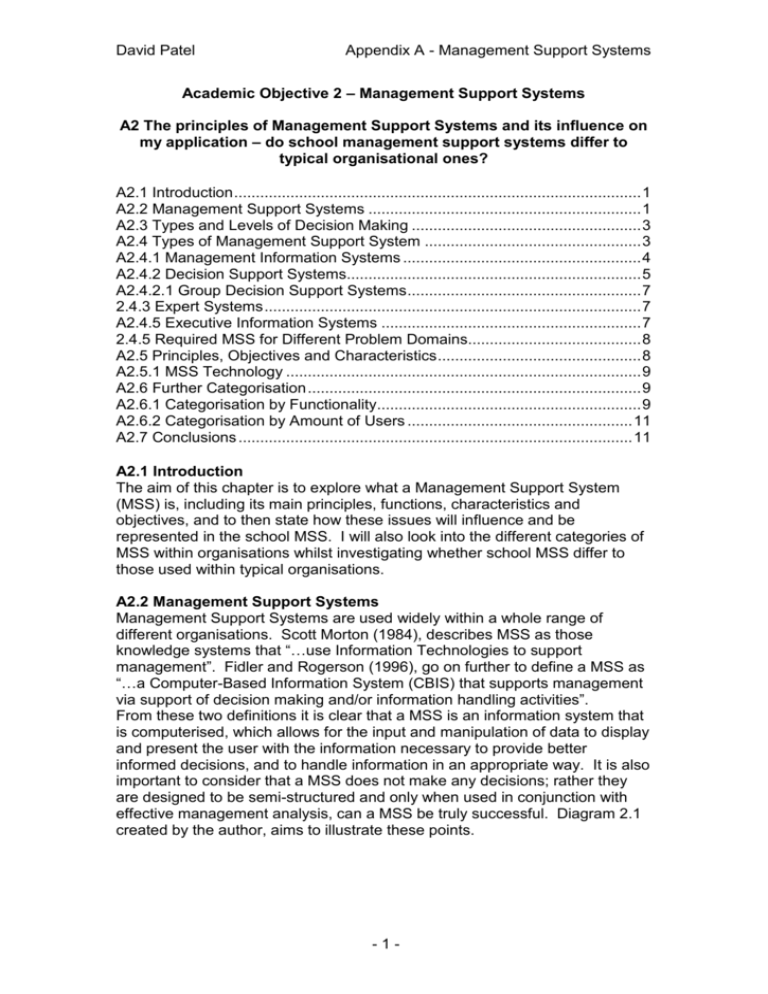
David Patel Appendix A - Management Support Systems Academic Objective 2 – Management Support Systems A2 The principles of Management Support Systems and its influence on my application – do school management support systems differ to typical organisational ones? A2.1 Introduction .............................................................................................. 1 A2.2 Management Support Systems ............................................................... 1 A2.3 Types and Levels of Decision Making ..................................................... 3 A2.4 Types of Management Support System .................................................. 3 A2.4.1 Management Information Systems ....................................................... 4 A2.4.2 Decision Support Systems.................................................................... 5 A2.4.2.1 Group Decision Support Systems ...................................................... 7 2.4.3 Expert Systems ....................................................................................... 7 A2.4.5 Executive Information Systems ............................................................ 7 2.4.5 Required MSS for Different Problem Domains........................................ 8 A2.5 Principles, Objectives and Characteristics ............................................... 8 A2.5.1 MSS Technology .................................................................................. 9 A2.6 Further Categorisation ............................................................................. 9 A2.6.1 Categorisation by Functionality............................................................. 9 A2.6.2 Categorisation by Amount of Users .................................................... 11 A2.7 Conclusions ........................................................................................... 11 A2.1 Introduction The aim of this chapter is to explore what a Management Support System (MSS) is, including its main principles, functions, characteristics and objectives, and to then state how these issues will influence and be represented in the school MSS. I will also look into the different categories of MSS within organisations whilst investigating whether school MSS differ to those used within typical organisations. A2.2 Management Support Systems Management Support Systems are used widely within a whole range of different organisations. Scott Morton (1984), describes MSS as those knowledge systems that “…use Information Technologies to support management”. Fidler and Rogerson (1996), go on further to define a MSS as “…a Computer-Based Information System (CBIS) that supports management via support of decision making and/or information handling activities”. From these two definitions it is clear that a MSS is an information system that is computerised, which allows for the input and manipulation of data to display and present the user with the information necessary to provide better informed decisions, and to handle information in an appropriate way. It is also important to consider that a MSS does not make any decisions; rather they are designed to be semi-structured and only when used in conjunction with effective management analysis, can a MSS be truly successful. Diagram 2.1 created by the author, aims to illustrate these points. -1- David Patel Appendix A - Management Support Systems Diagram 2.1: Management Support Systems – A Definition -2- David Patel Appendix A - Management Support Systems A2.3 Types and Levels of Decision Making The first step in understanding and trying to distinguish the differing types of MSS, is to understand the types of decisions they aim to assist with. These can be split broadly into three categories: 1. Unstructured Decisions – involves decision-making circumstances whereby it is often difficult to foresee most of the decision processes ahead. 2. Semi-Structured Decisions – whereby many decision processes can be foreseen, however still lacking a definite recommended solution without further assessment. 3. Structured Decisions – whereby the decision-making circumstances allow the decision processes to be foreseen in advance. Additionally there are generally three levels of decision-making (associated with the three levels of management), these are summarised in table 2.1, along with their typical characteristics. Table 2.1: Levels of Decision Making Long time horizons Large scale resources Unstructured and judgemental decisions Uncertainty and risk Intermittent decisions Difficult to define External and internal factors Tactical Medium to short term horizons (Middle-Management) Allocating limited resources Decisions about how policy is implemented Less uncertainty and risk Greater focus on internal factors Decisions limited to within bounds set by others Operational Short term horizons (Lower-Management) Small scale resources Structured decisions Little risk Regular and repetitive decisions Clear objectives and decisions Strategic (Top-Management) A2.4 Types of Management Support System Further exploration of a MSS in seeking its main principles and functions reveals that different types of MSS actually exist (or what could be considered MSS). This is due to the fact that CBIS incorporates many different types of information systems, including Transaction Processing Systems (TPS) such as till systems in retail shops, Management Information Systems (MIS) that can summarise transaction data, and automated office systems, which includes payroll systems for example. According to Sean (2001) MSS actually “… consist of DSS (Decision Support Systems), Expert Systems (ES) and Executive Information Systems (EIS)”. This raises another question, are all these computer based systems actually management support systems, as it seems that CBIS is a very general term to define MSS. Indeed, according -3- David Patel Appendix A - Management Support Systems to Finlay (1992), ”…there is a need for a common categorisation of types of Management Support Systems”. The amount of literature available on this topic is vast, different authors have various viewpoints on the subject and tend to categorise in slightly different ways albeit within a common theme. This can be illustrated with the above example of Sean (2001), who excludes MIS from a type of MSS, whereas Fidler and Rogerson (1996) categorically state MIS as a type of MSS, along with DSS, EIS, ES and GDSS (Group Decision Support Systems). In order to effectively understand management support systems, to gain knowledge of their principles and objectives, I have chosen to examine each one further to discover their main characteristics and purposes. This will also help in exploring whether school MSS differs to those used within other organisations. A2.4.1 Management Information Systems As stated above, MIS merely summarise transaction data, this is verified by Fidler & Rogerson (1996) who state that MIS were “… developed by many organisations to provide a set of periodic information reports to management”. Therefore MIS exist to provide support for routine operational decisions in an organisation. They aim to aid with relatively structured decisions and improve upon efficiency in this area, for instance by reducing costs through replacing clerical staff, and decision making can be made by managers once the appropriate information has been provided to them. The MIS can effectively collect, organise, store and retrieve data. Again this information usually comes from Transaction Processing Systems (also known as Electronic Data Processing (EDP). TPS are not MSS, rather subsets of MIS, or information systems in their own right, however individually they do not provide management with decision making assistance. There are criticisms of MIS, in that they may not actually reduce costs through providing batch reports, but only provide “… more timely and correct information”1. Additionally, according to Gray, P. (1994) MIS are often oriented “… toward transaction processing, record keeping, and cost accounting rather than decision making”. This is exemplified in a report which examines MIS in the Human Services industry, which states that systems “…typically focus on tracking of client or administrative activities (accounting, fund raising, human resources) without providing an integrated view of operations that is useful in guiding management decisions”2. According to the same source, for an MIS to be effective there are five important characteristics: 1. Ease of use – the system should be easy to use and require little training (including users with little computer knowledge) to acquire constructive information. 2. Meaningful – the system should provide meaning to data by summarising in useful methods and be formatted and presented effectively utilising graphs and tables for instance where necessary. 3. Multiple levels of detail – the system should connect multiple levels of detail enabling the user to view high level information first, and then dig into further detail if required (i.e. drilldown). 1 2 Finlay, P. 1989 http://www.socialent.com/resources/articles/pdfs/overviewtomgt.pdf -4- David Patel Appendix A - Management Support Systems 4. Flexibility – the system should be flexible enough to enable the user to sort data in different orders or be more selective with target groups of required data. 5. Accuracy – the system must be wholly accurate, providing credible information that does not require the user to verify data consistently. A2.4.2 Decision Support Systems Decision Support Systems (DSS) have been defined as “…an interactive computer-based system which facilitates solution of unstructured problems by a decision maker” (Sean, 2001). Other authors such as Mark Silver (1991) simply define it as a computer based information system (CBIS), and others add that it helps with both semi-structured as well as unstructured decisions. What is clear is that there does not seem to be one standard and accepted definition for DSS. Some authors even argue that DSS is just one form of MIS as there does not seem to be any significant differences between the two of where one starts and another finishes. Figure 2.2 summarises these viewpoints from various authors. However, despite this confusion, DSS still have defining principles and characteristics. DSS can provide support for decision makers at all levels of management, assisting with interdependent and sequential decisions. Paul Gray has developed and refined seven principles that a DSS should incorporate and adopt to become successful, which is based on other people’s research and findings as well as his own research and experience. Table 2.2 has been adapted from Gray, P. (1994), it lists his seven principles along with the corresponding characteristics which a DSS should adopt to prove the effectiveness of such a system. Table 2.2: Seven Principles for DSS Success Principle 1. DSS should improve decision making 2. DSS should contain as much “intelligence” about the user’s problem as possible 3. DSS should be used through whatever usage pattern is most cost effective 4. DSS should be used by experts who understand what they mean and how they should be used Corresponding DSS Characteristic Support and aid decision making rather than automated decision making Stress effectiveness rather than efficiency Should support all phases of the decision process Should not impose a decision process on a decision maker Help with semi-structured and unstructured decisions -5- Used directly by managers Interactive Easy to use Cosmetically appealing Used directly by managers David Patel Appendix A - Management Support Systems 5. DSS should be controllable by users 6. DSS should contain whatever data, models, display capabilities, and human intermediaries are needed 7. DSS should be implemented through whatever development strategy is most cost effective and least risk prone in the setting Controllable by the user Easy to use Flexible Shouldn’t impose a decision process on the user Contain broad data bases Integrate models and data bases Contain graphical capabilities Does not contain automatic optimisation Design must be evolutionary Should be built using prototypes Fig. 2.2: Relationships Between MIS and DSS3 3 Finlay, P. 1989 -6- David Patel Appendix A - Management Support Systems A2.4.2.1 Group Decision Support Systems The main difference between Group Decision Support Systems (GDSS) and lone-user DSS is that they facilitate solutions of problems “… by a set of decision makers working together”4, as opposed to individually. Obviously the technology required to comply with this situation would need to be altered (use of networking for instance), however the main principles and objectives remain the same. 2.4.3 Expert Systems Expert Systems (ES) arose in the 1980s based on Artificial Intelligence research and technology, they aim to “… replace and mimic human decision makers in making repetitive decisions in a narrow domain” (Sean, 2001). ES manages this by dealing with problems and situations where human competence is required rather than human specialist expertise, utilising builtin logic rules. They can also be designed to provide specific advice within a specialised area, for example (… whether a particular merger with a given company would be a good move for a particular organisation”. Therefore the distinction between ES and other MSS is that ES seems to replace the human decision maker in a specific area, whereas MSS aid the decision maker in broader areas. However, according to Silver (1991) Expert Systems are not MSS within their own right but rather a “… subclass of DSS”. Finlay (1992) backs up this argument by stating that ES should not “… be considered a distinct class of MSS”. Despite this ES can be combined and integrated with DSS and EIS. A2.4.5 Executive Information Systems In contrast to both MIS and DSS, an Executive Information System (also referred to as Executive Support Systems, ESS) has been defined as an “…important tool to serve the information needs of executives” (Sean, 2001), with Watson (1997) adding that it is “…a computerised system that provides executives with easy access to internal and external information that is relevant to their critical success factors”5. This insinuates that EIS are only used by top-level executives within a firm, with the focus to provide some kind of advantage by aligning information with business objectives and goals. Indeed, companies are looking toward computerised systems to “gain competitive advantage over rivals”6, and EIS would seem to fit this bill by seeking to gain a strategic advantage by assessing both internal and external environments to seek factors vital to the businesses success. According to Watson (1997), EIS are tailored to individual executives, usually by functional department, and this is corroborated by Silver (1991) who states that the features of the system should “…reflect the unique needs of executives”. An EIS will extract, filter, compress data into and track critical data, from both internal and external databases, aiding top management with unstructured decision making, with information presented in a tabular format, graphically, or textually. The information can encompass exception reporting, trend analysis and incorporates drilldown techniques whereby the user can access the detail of summarised data. As EIS are designed to be handled 4 Sean, B. 2001 Watson, H.I. et al 1997 6 Fidler, C., Rogerson, S. 1996 5 -7- David Patel Appendix A - Management Support Systems and used by executives it is essential that they are as user-friendly as possible and “…require little or no training to use” (Watson, 1997). An unconventional feature of an EIS compared with other support systems is in its communication abilities and many incorporate email and computer conferencing abilities and also integrate electronic diaries and phonebooks. 2.4.5 Required MSS for Different Problem Domains From examining the different types of MSS available, a matrix table has been designed (see table 2.3) to show typical examples of problems and tasks that each MSS can support, which is divided into the type and level of decision making required. Table 2.3: MSS Required to Support Different Types and Levels of Decision Making Type of Decision Structured Level of Decision Making Strategic Tactical Operational Investment Warehouse location SemiStructured Unstructured Support System Required Building new plant Budget analysis Accounts receivable Short-term forecasting Credit evaluation Order entry Mergers and Project acquisitions planning R&D planning Negotiating New technology development Recruiting an executive EIS ES MIS, DSS, EIS, ES Support System Required MIS Production scheduling DSS ES Inventory control Buying software DSS ES Selecting a cover for magazine MIS A2.5 Principles, Objectives and Characteristics Although there are different types of MSS, they all seem share common characteristics to meet their objectives (although there are distinguishing features in some instances). Sprague and Watson (1986) have summarised the characteristics which define an MSS as: 1. Tendency to be aimed at the less well-structured, underspecified problems that upper level management face. 2. Attempt to combine the use of models or analytic techniques with traditional data access and retrieval functions. 3. Specifically focus on features which make them easy to use by noncomputer people in an interactive mode. -8- David Patel Appendix A - Management Support Systems 4. Emphasise flexibility and adaptability to accommodate changes in the environment and the decision making approach of the user. Again, these common elements point to a computer based system which can be used by users who may not be highly experienced with computers, aiming to help with semi-structured and unstructured problems. At the moment there does not seem to be any distinction between a school MSS compared to an organisational MSS. An MSS type and capabilities, rather than the type of organisation it is being used in, defines an MSS. A2.5.1 MSS Technology Another common element to MSS is the hardware and software required to run it. Typically, the MSS software will consist of three components: 1. Data Management – comprising of the main database which will house data from Transaction Processing Systems for example, and data from external sources (if required). 2. Model Management – the software system required to analyse the data. This will include query and report designers. 3. User Interface – this must be as user-friendly as possible due to not being necessarily used by IT staff, presenting findings well in an appropriate manner. According to one source7, MSS software tools are not expensive, ranging between approximately £300 and £800. This range of tools includes: Crystal Reports (Seagate Software) Intelligent Query (IQ Software) Impromptu (Cognos) Power Play (Cognos) Additionally, database management systems that provide data analysis and reporting functions such as Microsoft Access, Oracle 2000 and Borland FoxPro, can all be utilised in building MSS. All these applications will run on a standard PC of today. A2.6 Further Categorisation Thus far Management Support Systems have been categorised by the types of MSS available, including MIS, EIS and DSS. Although this helps in finding a category to fit the school MSS into, there are other methods which have been discussed by various authors to categorise MSS in differing ways. This section aims to explore those viewpoints in further seeking a solution to categorising a school MSS. A2.6.1 Categorisation by Functionality A logical framework has been developed by Fidler and Rogerson (1996) for viewing MSS functionality and capability. Their framework has been adopted and is represented in figure 2.3 overleaf. 7 http://www.socialent.com/resources/articles/pdfs/overviewtomgt.pdf -9- David Patel Appendix A - Management Support Systems Fig. 2.3: Logical Framework For Viewing MSS Capabilities MSS Decision Making Information Handling Passive As-needed Active Periodic As-needed Periodic As can be seen in figure 2.3 above, MSS capabilities can be divided into those that are designed with the primary purpose of information handling; and those that aid decision making. Decision making is further categorised by either passive or active decision making, both of which can be provided on either a periodic (e.g. monthly, quarterly, yearly, etc) or alternatively on a asneeded and required basis. At this stage it is crucial to understand that a MSS does not just do either information handling or decision making, rather an amalgamation of the two functions will be used to create a fully functional MSS, and information handling will inevitably have a role in attributing to the decision making process. Also, as-needed functions can consist of the functions found in periodic functions e.g. monthly sales figures may need to be reproduced with the latest sales figures available at any point in time. In terms of information handling an MSS will need to manage both information preparation (via data entry) and communication. Information will need to be stored electronically through an appropriately designed MSS format, and then communicated and presented via a suitable media format (e.g. textually, graphically). It is important to consider how to classify what Fidler and Rogerson (1996) interpret as passive and active decision making. Passive decision making has been defined as those activities which are concerned with “…the provision of information reports which can be used to support management decision making activities” (such as Microsoft Access reporting capabilities). Whereas active decision making “…involves the provision of mechanisms for the analysis and manipulation of information interactively to provide greater insight into the decision situation and associated options” (such as Microsoft Access queries which provide an option to select and display required data). - 10 - David Patel Appendix A - Management Support Systems A2.6.2 Categorisation by Amount of Users Finlay’s (1992) categorisation of MSS in its broadest form implies that the main distinction between types of MSS can be divided into two very distinct categories, either: Lone-user MSS Group MSS (GMSS) Management Support Systems can be designed to be used by an individual manager or by a group of users. His theory is that lone-user MSS increase and enhance interaction with the user, which should eventually lead to a more through analysis and highly focused decisions. However GMSS require individuals to meet before decisions can be generated in a group context (not dissimilar to section A2.4.2.1 GDSS). A2.7 Conclusions In examining Management Support Systems, what becomes clearly apparent is that there are discrepancies and confusion with naming conventions and definitions of differing types of MSS. Indeed, there seems to be no widely accepted standard sets of definitions. However, what is clear and prominent is that a MSS is a computer based system which aids and assists the decision maker, it does not make decisions for them (such as expert systems), and does not consist of all information systems (such as Transaction Processing Systems), although these can be incorporated into a MSS if necessary. Three main categories of MSS exist, each with common and distinguishing features and functionality to help with differing problem domains, assisting different levels of management. These consist of MIS, DSS and EIS. MIS help with structured decisions on an operational level, DSS with semistructured and unstructured decisions on a tactical level, and EIS with semistructured and unstructured decisions on both strategic and tactical levels. Additionally MIS deals with past data and makes no attempt to foresee the future or apply context dependent analysis as with DSS and EIS. It could be argued that MIS is incorporated into all MSS, and conforms to the information handling and passive decision making objectives in Fidler and Rogersons framework of functionality (section A2.6.1). DSS can handle both these functions, in addition to active decision making, and an EIS is an amalgamation of the two systems, however it takes into account both internal and external data and can provide communication abilities. It is also important to consider that there are two types of categories of MSS within those discussed above, these are lone-user MSS and group-user MSS. Group-user MSS add networking abilities and assist a group of decision makers. The main principles and characteristics of these MSS have been highlighted throughout this document, however to summarise the main points, an MSS must be: User-friendly and easy to use, requiring minimal or no training Provide meaningful information across multiple levels Contain intelligence to assist with less-well structured problems Have strong display capabilities in different formats if required Be flexible and adaptable to cope with environmental changes In answering the original question, do school MSS differ to typical organisational ones? The simple answer is no. This is due to the fact that - 11 - David Patel Appendix A - Management Support Systems MSS are not categorised by the type of organisation they are being used in, but by the functionality they offer. The school MSS is certainly a lone-user MSS as it is to be used singly by the assessments coordinator at Shaftesbury Junior School in making decisions. The proposed system should assist with both passive and active decision making activities. Therefore the school MSS could be defined as a DSS, aiding middle management with tactical level operations. Companies are looking toward computerised systems to gain competitive advantage over rivals, to achieve economies of scale and use resources effectively. However in the context of the school system, it is not about gaining a competitive advantage, but rather a system to help provide a better service to their pupils, by identifying those pupils who are underachieving or not performing to their full potential, this can be pointed out and something can hopefully be done about this. So in this context, yes an MSS does differ in education compared with business usage, as the emphasis and purpose is slightly different. However it can also be argued that the principles are the same, seeking to use resources effectively, and gaining competitive advantage over other schools by improving overall performance. Therefore it is justified in stating that school MSS do not differ from typical organisational ones. From examining MSS, the effect upon my system is that managers expect value from a system, to achieve this the system has to conform to the organisational objectives and strategy. Therefore my system will have to comply with the requirements requested of it to realise this objective and comply with the main characteristics of MSS discovered throughout this chapter (in particular with those associated with DSS). - 12 -
